

Eportfolios for Meaningful Student Learning. JISC Guide... Using digital media for your eportfolio. E-Portfolios are an important part of many learners' academic life.
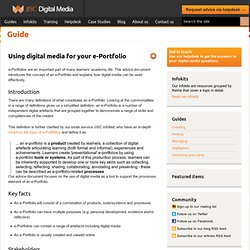
This advice document introduces the concept of an e-Portfolio and explains how digital media can be used effectively. Introduction There are many definitions of what constitutes an e-Portfolio. Looking at the commonalities in a range of definitions gives us a simplified definition: an e-Portfolio is a number of independent digital artefacts that are grouped together to demonstrate a range of skills and competencies of the creator.
This definition is further clarified by our sister service JISC infoNet, who have an in-depth infokit on the topic of e-Portfolios and define it as: ... an e-portfolio is a product created by learners, a collection of digital artefacts articulating learning (both formal and informal), experiences and achievements. Home - FolioSpaces free ePortfolio - 2GB free storage - free institutional hosting - teachers - students - school - college - university. Online Portfolio Tools. Much of this work began with my Online Portfolio Adventure, where I recreated my presentation portfolio with at least 33 different online services, software and strategies between September 2004 and the present time.
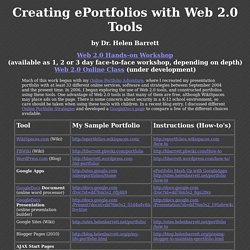
In 2006, I began exploring the use of Web 2.0 tools, and constructed portfolios using these tools. One advantage of Web 2.0 tools is that many of them are free, although WikiSpaces may place ads on the page. There is some concern about security in a K-12 school environment, so care should be taken when using these tools with children. In a recent blog entry, I discussed different Online Portfolio Strategies and developed a GoogleDocs page to compare a few of the different choices available.
Crossing the threshold: moving e-portfolios into the mainstream. 1 View or download this publication in accessible PDF format2 What the publication offers Despite pockets of good practice across the disciplines, wide-scale adoption of e-portfolios across further and higher education institutions has been less commonly achieved, and where large-scale implementation has occurred, little has been shared to inform the work of others.
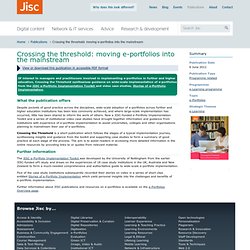
Now a JISC-funded e-Portfolio Implementation Toolkit and a series of institutional video case studies have brought together information and guidance from institutions with experience of e-portfolio implementation to assist universities, colleges and other organisations planning to mainstream their use of e-portfolios.
Crossing the Threshold is a short publication which follows the stages of a typical implementation journey, synthesising insights and guidance from the toolkit and supporting case studies to form a summary of good practice at each stage of the process. Further information. 12 Important Trends in the ePortfolio Industry for Education and for Learning. ePortfolio Vendors Comment on Their Market: Summary of Interview Findings Extensive interviews with 14 ePortfolio vendors revealed key directions and interesting developments in that industry.

Below are the 12 most notable findings. 1New companies. New companies are entering the market. In this list are three companies I have not talked with before: SchoolChapters, Bedford/St. 2Larger scale implementations. 3Greater sophistication on campus. 4Selling to individuals. 5More mobility. 6Tenuous international markets. 7A maturing K-12 sector. 8Corporate market interest. 9Alternate certification of learning. 10The merging of LMS and ePortfolio technologies. 11Market segmentation. 12The move to Web 2.0 native architectures. ePortfolios, at least the learner-focused modules or applications, do not in theory need to be tethered to an educational institution. ePortfolios as learning-enablers may come into their own when they become consumer applications marketed to the larger general market.
Features. What makes Mahara different from other ePortfolio systems is that you control which items and what information (artefacts) within your portfolio other users see.
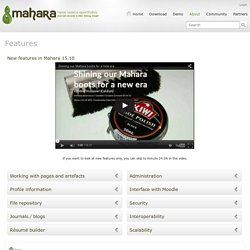
In order to facilitate this access control, all artefacts you wish to show to other users need to be bundled up and placed onto a page. You can have as many pages as you like, each with a different collection of artefacts, and intended purpose and audience. Your audience, or the people you wish to give access to your page, can be added as individuals or as a member of a group or community. ePortfolio owners create pages using a 4-step process, and page have the following features: ePortfolios with GoogleApps.
This Google Site has been set up by Dr.
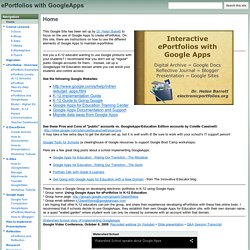
Helen Barrett to focus on the use of Google Apps to create ePortfolios. On this site, there are instructions on how to use the different elements of Google Apps to maintain e-portfolios. Are you a K-12 educator wanting to use Google products with your students? I recommend that you don't set up "regular" public Google accounts for them... instead, set up a GoogleApps for Education domain where you can enroll your students and control access.
See the following Google Websites: See these Pros and Cons of "public" accounts vs. Google Tools for Schools (a clearinghouse of Google resources to support Google Boot Camp workshops) Here are a few great blog posts about a school implementing GoogleApps: Watershed School story of implementing GoogleAppsGoogle Video Conference, October 6, 2009: Recorded webinar (in Youtube) • Slide presentation • Q&A Session Transcript.